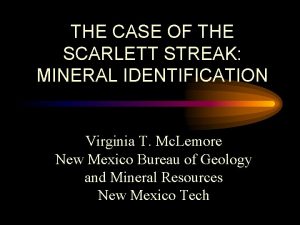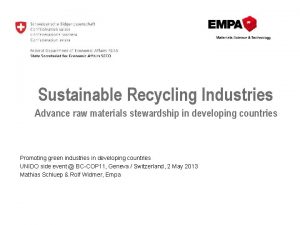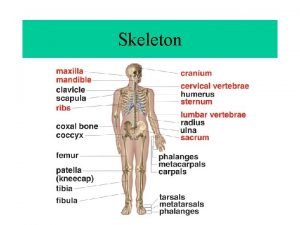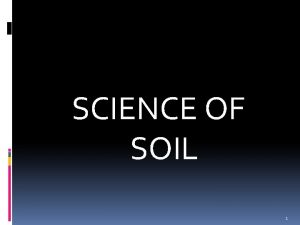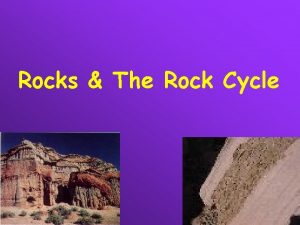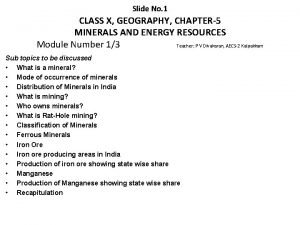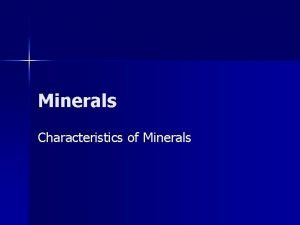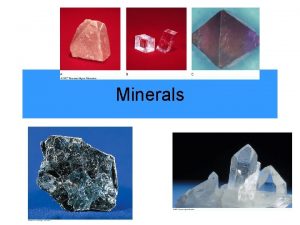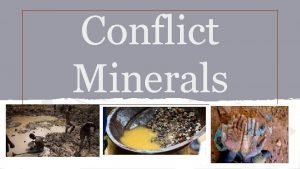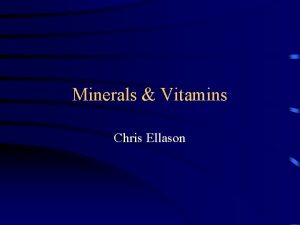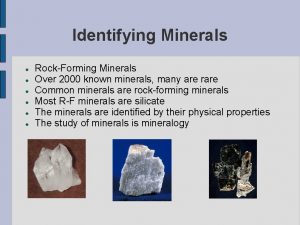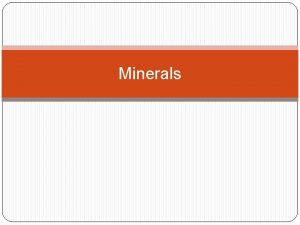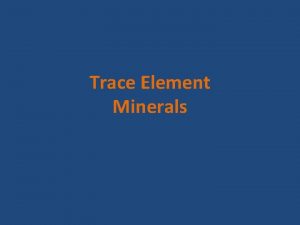Slide No 1 CLASS X GEOGRAPHY CHAPTER5 MINERALS










- Slides: 10

Slide No. 1 CLASS X, GEOGRAPHY, CHAPTER-5 MINERALS AND ENERGY RESOURCES Module Number 2/3 Teacher: P V Divakaran, AECS-2 Kalpakkam • • • Non-Ferrous Minerals Copper: its features Production of Copper showing state-wise Bauxite-Features and areas of Bauxite Deposits Bauxite Mine-Image Non-Metallic Minerals Mica: areas of mica deposits Limestone: Uses of limestone Production of Limestone showing state-wise share Hazards of Mining Conservation of Minerals

Slide No. 2 Non-Ferrous Minerals • • • Minerals that do not contain iron content are called non-ferrous minerals. These include copper, bauxite, lead, zinc and gold They play an important role in metallurgical, engineering and electrical industries. Copper Features: § § § It is an excellent electrical conductor (low resistance to electricity). It is malleable and ductile. It is mainly used in electrical, electronics and chemical industries. India is deficient in the reserve and production of copper. Mining Areas: 1. The Balaghat mines in Madhya Pradesh 2. Khetri mines in Rajasthan 3. Singhbhum district of Jharkhand

Slide No. 3 Production of Copper showing state-wise share in per cent, 2009 -10

Slide No. 4 Bauxite • Bauxite ore is used for obtaining aluminium. • It is a clay like substance from which first alumina and then aluminium is made. • Bauxite is formed due to the decomposition of rocks rich in aluminium silicates. • Features: – Aluminium is known for its strength – Aluminium is known for its lightness – Aluminium is known for good conductivity – It is malleable – It is used in manufacturing of utensils, electrical goods, etc. • Areas of Bauxite Deposits: – Amarkantak plateau (M P and Chatishgargh boarder) – Maikal hills ( Maharastra and Chatishargh boarder) – The plateau region of Bilaspur (Chatishgarh), Katni (M P) – Panch patmali deposits in Koraput district of Odisha

Slide No. 5 Bauxite Mine-Image

Slide No. 6 Non-Metallic Minerals Mica: § § § § It is a mineral made up of a series of plates or leaves. It can be easily split into thin sheets. It can be clear, black, green, red yellow or brown. It has excellent di-electric strength. It has low power loss factor. It has insulating properties. It is resistant to high voltage It is used in electric and electronic industries. Areas of Mica deposits: o o Northern edge of the Chota Nagpur plateau Koderma Gaya – Hazaribagh belt of Jharkhand Ajmer in Rajasthan Nellore in Andhra Pradesh

Slide No. 7 Limestone What is limestone? • • Limestone is a rock mineral found in sedimentary rocks It is composed of calcium carbonates or calcium and magnesium carbonates Use of limestone: • • Limestone is the basic raw material for the cement industry It is essential for smelting iron ore in the blast furnace Production of Limestone showing state-wise share in per cent, 2009 -10

Slide No. 8 Hazards of Mining • Mining is a hazardous industry. • It is also known as killer industry due to the following reasons: o No natural light inside the mines make working tougher. o Risk to life due to collapse of roofs, overflow of water and fire. o Dumping of waste and slurry leads to degradation of soil and river pollution o The dust and harmful fumes cause pulmonary diseases to miners. What are the measures? • Safety regulations should be made stricter. • Environmental laws should be implemented to prevent mining from becoming a “killer industry”.

Slide No. 9 CONSERVATION OF MINERALS • Why should we conserve minerals? • Mineral resources are finite and non-renewable. • We are rapidly consuming mineral resources • These resources require millions of years to be created Therefore it is important to conserve mineral resources and use it judiciously. How can we conserve mineral resources? We can conserve minerals in the following ways: o Mineral resources should be used in a planned and sustainable manner. o Technologies should be developed to use lower grade minerals at lower costs o Metals should be recycled o Alternative materials should be used so that minerals can be conserved.

Slide No. 10 Recapitulation 1. 2. 3. 4. 5. 6. 7. Distinguish between ferrous and non-ferrous minerals. What are the properties of mica? Why is conservation of mineral resources essential? Explain any three methods to conserve them. What are the uses of copper? What is bauxite? What are the chief characteristics of bauxite? What are the hazards of mining? What are the measures? “Minerals are indispensable part of our lives” Explain it.






